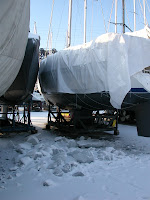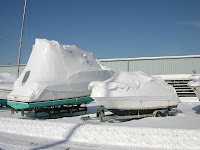 Covering the boat at the end of a Great Lakes boating season is no one’s idea of a good time. The season’s over, the days are shorter and putting the boat away is no small task. Make this big task a little easier by having a plan and the right equipment.
Covering the boat at the end of a Great Lakes boating season is no one’s idea of a good time. The season’s over, the days are shorter and putting the boat away is no small task. Make this big task a little easier by having a plan and the right equipment. Making and/or applying a good cover is time-consuming and hard work, but the reward is a clean, dry boat when the cover comes off in the spring. The penalty for skimping could be serious damage. A lot of do-it-yourselfers spend hours creating a canopy with the intention of protecting the boat in high winds, heavy snowfall or heavy rains. Unfortunately, time spent does not equal the protection gained.
When planning to cover your boat, you have a few options: buy an inexpensive tarp, order a custom cover, or shrink wrap. Each option has pros and cons, but they all share an important component: a strong frame to support the cover of your choice.
Whatever cover you choose, it must be supported underneath. Otherwise, it can create pockets that collect water, which turns into ice, which adds exponential weight on your cradle or trailer and can damage your boat. Traditional wooden frames are expensive, clumsy and time-consuming to build. They are also difficult to store. You can buy clamps that allow you to custom-build a frame out of steel electrical conduit. These frames are easy to store and erect year after year. Plastic pipe can also be used to build a framework in a similar manner.

Collapsing and torn tarps are usually the consequence of those purchased from home building supply stores that are not installed securely. Although these inexpensive covers can be effective, they must be secured to stand up to very high winds, rain and snow. The key with these tarps is to fit them tightly so they don’t flap in the wind. A flapping cover can wear itself out in one or two storms. Worse, winter-long movement of the cover or the tie-down ropes against fiberglass can scratch or completely wear through the gel coat. Brass grommets flailing in a 40-knot wind will destroy gel coat in one afternoon.
This canopy collected the huge
chunks of ice you see on the ground
 Plastic tarps cost a lot less than real canvas, but a custom canvas cover will last longer and is a better fit. Good quality plastic will last a full winter, but by spring there will be worn spots and the grommets will have begun to pull out of the hem. Canvas tarps are heavier, so they don't flap as much. A good canvas shop should turn out a fitted cover that virtually never flaps, even in high winds. Sure, it will move in the wind, but not flap around like an ordinary tarp. This means less likelihood of fiberglass damage from tie-down ropes, grommets or the canvas.
Plastic tarps cost a lot less than real canvas, but a custom canvas cover will last longer and is a better fit. Good quality plastic will last a full winter, but by spring there will be worn spots and the grommets will have begun to pull out of the hem. Canvas tarps are heavier, so they don't flap as much. A good canvas shop should turn out a fitted cover that virtually never flaps, even in high winds. Sure, it will move in the wind, but not flap around like an ordinary tarp. This means less likelihood of fiberglass damage from tie-down ropes, grommets or the canvas.  The most hassle-free of all options is shrink wrap. Boat builders initiated the use of this plastic material to protect new boats while they were being shipped via truck. Now shrink wrapping is available to any boat owner. You cannot shrink wrap your boat yourself. A team of professionals equipped with expensive tools cover your boat with a special plastic that shrinks to the shape of your boat when heat is applied. The plastic needed is not sold through retail stores. Because of the labor and materials involved, shrink wrapping is somewhat expensive. And, it is nearly impossible to re-use a shrink wrap cover so you must buy a new one each season.
The most hassle-free of all options is shrink wrap. Boat builders initiated the use of this plastic material to protect new boats while they were being shipped via truck. Now shrink wrapping is available to any boat owner. You cannot shrink wrap your boat yourself. A team of professionals equipped with expensive tools cover your boat with a special plastic that shrinks to the shape of your boat when heat is applied. The plastic needed is not sold through retail stores. Because of the labor and materials involved, shrink wrapping is somewhat expensive. And, it is nearly impossible to re-use a shrink wrap cover so you must buy a new one each season. Shrink wrap covers are the tightest of all covers. They don’t flap, chafe, scratch or wear the fiberglass. They cover so well that decks emerge nearly as clean as they were the day the boat was covered.
In the long run, a fitted cover and its supporting framework is probably the most cost-effective way of covering your boat. Over eight or ten winters, you'll spend a lot more on plastic or canvas tarps than you will on a fitted cover. The only problem is coming up with the money to cover the initial cost.

No comments:
Post a Comment